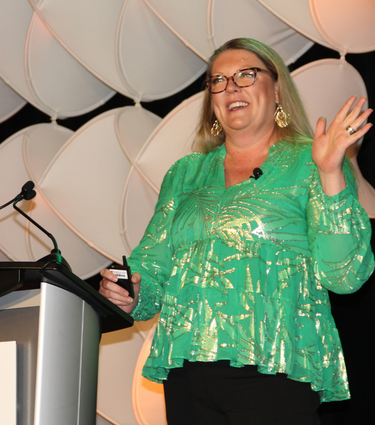Beyond Cryotherapy: Treating “Warts and Molluscum and Kiddos…Oh MY!”
Shanna Miranti, MPAS, PA-C, started her engaging afternoon lecture with the advice, “all of you need to become experts in pediatric dermatology because it’s visual and you will receive pictures, text messages, etc. from your neighbors, friends, family members” of kids’ dermatologic conditions asking for your help. More seriously, because there are only about 300 pediatric dermatologists practicing throughout the country, dermatology PAs need to embrace the field to fill the gap in care. PA Miranti outlined the pathophysiology, clinical presentation, first-line treatment and recalcitrant treatment options for warts. While cryotherapy is an effective option, it is important to remember there can be complications and side effects from cryotherapy. For example, the pain of cryotherapy can be a limiting factor with kids. Additional adverse effects can include local nerve damage, hypopigmentation, scarring and ulceration. In addition to cryotherapy, destructive methods for warts include pulsed dye laser, electrodessication and bleomycin. Immunomodulating options include intralesional (IL) candida, IL Vitamin D3, IL MMR and IL HPV quadrivalent vaccine.
Coverage: SDPA 20th Annual Fall Dermatology Conference Nov. 17-20, 2022, in Miami
PA Miranti urged the attendees, “no matter what method you choose, please take the time to counsel the parents and have the patient on your side.” She reminded providers when dealing with pediatric patients, you are typically working with at least two people in the room (e.g., patient and parent). Additional options for the treatment of warts include compounded salicylic acid and 5-fluorouracil (5FU), duct tape, cantharidin and scalpel paring with cryotherapy. A unique treatment option which PA Miranti reviewed is Swift-TM Microwave treatment. This in-office device heats to 150 degrees and is applied directly to the warts. This treatment usually takes three treatments and costs about $200-250 per treatment. A benefit of this treatment is there is no pain for the patient after. An additional novice treatment option includes SADBE—3% squaric acid dibutyl ester—which is compounded in an acetone solution. This treatment is great for periungual warts or multiple warts. As it is an immunotherapy treatment, it does require that patients have an intact immune system to mount an appropriate immune response.
Finally, treatment of molluscum contagiosum (MC) was highlighted. Despite 6 million Americans suffering from MC each year, there is no FDA approved treatment for it. While MC may resolve spontaneously, this can take an extensive amount of time, from 6 months to 4 years, and untreated MC can leave pox scars. One option for treatment is compounded acyclovir, cimetidine, imiquimod, salicylic acid and tretinoin to be applied to the MC lesions. She discussed two new, exciting options awaiting FDA approval. One is a drug-device combination containing cantharidin 0.7% (VP-102; Verrica), which, if approved, will be marketed under the brand name “Ycanth,” and available with an in-office prescription to include drug and device. Another option is berdazimer gel 10.3% (SB206; Novan), a nitric oxide releasing medication that is applied by the patient and parent at home. PA Miranti concluded the lecture with tips on how best to approach the pediatric patient. She encouraged the attendees to be engaged with pediatric patients, “If they feel like they have an ally in the room, they are much more likely to buy in.”
Byline: Sarah B.W. Patton, PA-C
Pictured: Shanna Miranti, MPAS, PA-C, Riverchase Dermatology
